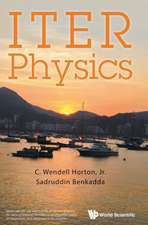Three Mile Island, Chernobyl and Fukushima: Curse of the Nuclear Genie
Autor Thomas Filburn, Stephan Bullarden Limba Engleză Hardback – 17 noi 2016
| Toate formatele și edițiile | Preț | Express |
|---|---|---|
| Paperback (1) | 470.84 lei 38-44 zile | |
| Springer International Publishing – 22 apr 2018 | 470.84 lei 38-44 zile | |
| Hardback (1) | 551.67 lei 38-44 zile | |
| Springer International Publishing – 17 noi 2016 | 551.67 lei 38-44 zile |
Preț: 551.67 lei
Preț vechi: 681.07 lei
-19% Nou
Puncte Express: 828
Preț estimativ în valută:
105.57€ • 114.64$ • 88.68£
105.57€ • 114.64$ • 88.68£
Carte tipărită la comandă
Livrare economică 19-25 aprilie
Preluare comenzi: 021 569.72.76
Specificații
ISBN-13: 9783319340531
ISBN-10: 3319340530
Pagini: 152
Ilustrații: X, 120 p. 25 illus., 3 illus. in color.
Dimensiuni: 155 x 235 x 14 mm
Greutate: 0.39 kg
Ediția:1st ed. 2016
Editura: Springer International Publishing
Colecția Springer
Locul publicării:Cham, Switzerland
ISBN-10: 3319340530
Pagini: 152
Ilustrații: X, 120 p. 25 illus., 3 illus. in color.
Dimensiuni: 155 x 235 x 14 mm
Greutate: 0.39 kg
Ediția:1st ed. 2016
Editura: Springer International Publishing
Colecția Springer
Locul publicării:Cham, Switzerland
Cuprins
Fukushima, Chernobyl and Three Mile Island, How we got there.- Chapter 1. Nuclear Fundamentals.- Chapter 2.Fukushima, design facts.- Chapter 3.Great Japan Earthquake and Fukushima accident history Eg Units 5 & 6 untouched by tsunami, because cliff was not removed for them Ge design, back up turbine/generator in basement Recovery effort status.- Chapter 4.Fukushima Daiichi today.- Chapter 5 BWR design history, why GE, Borax experiments GE, Vallecitos, Dresden GE design duplicated at Fukushima, including diesels in basement.- Chapter 6.Zircalloy clad fuel elements, history, H2O electrolysis at high temp, H2 gen.- Chapter 7. station blackout previously considered non credible accident.- Chapter 8.Chernobyl accident history.- Chapter 9.Graphite moderated reactor Russian history, Chicago pile to weapons production.- Chapter 10.Leningrad and other RBMK problems, precursor to Chernobyl disaster.- Chapter 11.TMI.- Chapter 12. PWR selected because of USnavy preference.- Chapter 13.Conclusion.
Textul de pe ultima copertă
This book examines the three most well-known and socially important nuclear accidents. Each of these accidents had significant, yet dramatically different, human and environmental impacts. Unique factors helped shape the overall pattern and scale of each disaster, but a major contributing factor was the different designs used for each reactor. Fukushima was a boiling water reactor (BWR), Chernobyl was a graphite moderated boiling water reactor, and TMI was a pressurized water reactor (PWR). This book traces the history of nuclear power and the development of each reactor type. We examine how GE’s work with a sodium cooled design did not fare well with the US Navy, and led GE to promulgate the BWR design. We explore the Russian atomic bomb program, its use of graphite moderated reactors, and their design modifications to create power production units. We trace the developments in the US that led the US Navy to select the PWR design, and caused the PWR to be used for nearly 2/3 of all US commercial reactors. In sum, the book uses the three major nuclear accidents as a lens to trace the technological history of nuclear energy production and to link these developments with long-term societal and environmental consequences. The book is intended for readers with an interest in nuclear power and nuclear disasters. The detailed and compelling account will appeal to both the expert and the interested lay-person.
Caracteristici
Shows historical context for development of the three reactors involved in the most notable nuclear accidents Details accident timelines for TMI, Chernobyl and Fukushima, with consequences to local population Intricate details of incidents/technologies that greatly impacted accidents (Steam Generator design at TMI, Chernobyl accident started with safety exercise, Fukushima hillside removed to save pump power)




















